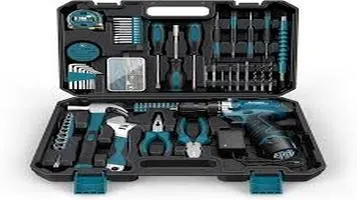The Power Drill - An Essential Tool for Every Toolbox
A power drill is a versatile and essential tool for both professional tradespeople and DIY enthusiasts, designed to make drilling holes and driving screws efficient and effortless. Equipped with an electric motor, power drills can be corded for continuous power or cordless for enhanced mobility and convenience. Featuring adjustable speed and torque settings, they accommodate various materials such as wood, metal, and plastic. Modern power drills often include a rechargeable lithium-ion battery, LED lights for improved visibility in dimly lit areas, and an ergonomic design to reduce user fatigue. With interchangeable drill bits and attachments, they can be used for a range of tasks, from assembling furniture to performing complex construction projects, making them indispensable in any toolkit.

When it comes to versatile and indispensable tools in any DIY enthusiast or professional’s toolkit, the power drill stands out as a quintessential piece of equipment. Whether you are assembling furniture, hanging shelves, or tackling more complex construction projects, a reliable power drill can make all the difference. In this review, we will dive deep into the features, performance, pros, and cons of power drills, helping you make an informed decision for your next purchase.
Design and Build Quality
One of the first things to notice about a power drill is its design and build quality. Modern power drills are typically designed with ergonomics in mind, ensuring comfortable use over extended periods. High-quality drills often feature rubberized grips and well-balanced bodies that contribute to reduced user fatigue. The placement of controls, such as the trigger and forward/reverse switch, is usually intuitive, allowing for ease of use even for beginners.
The materials used in the construction of power drills are also worth noting. Premium models often boast robust, impact-resistant housings made from high-grade plastics or composites, which protect the internal components from damage. Metal components, such as keyless chucks and gearboxes, add to the durability and longevity of the tool.
Performance and Power
Performance is arguably the most critical aspect of any power drill. The key factors to consider here are the motor power, speed settings, and torque. Power drills are generally available in corded and cordless variants, each with its own set of advantages.
Corded drills tend to offer more consistent power output and are well-suited for heavy-duty tasks. They are rated in amperes (A), with higher amperage indicating more powerful motors. For instance, a 7-amp corded drill is typically sufficient for most household tasks, while professionals might opt for 10-amp models for more demanding applications.
On the other hand, cordless drills offer unparalleled convenience and portability. They are powered by rechargeable batteries, usually lithium-ion (Li-ion), which provide a good balance between power and battery life. The voltage of the battery is a key indicator of performance, with common ratings ranging from 12V to 20V. A 20V cordless drill, for example, delivers ample power for both light and medium-duty tasks.
Speed settings and torque control are also vital for the drill’s versatility. Many power drills feature variable speed triggers and multiple speed settings, allowing users to adjust the RPM (revolutions per minute) according to the task at hand. Additionally, adjustable torque settings ensure that you can drive screws to the desired depth without stripping them or damaging the material.
Features and Accessories
Modern power drills come equipped with a plethora of features and accessories that enhance their functionality and ease of use. Some of the notable features include:
- Keyless Chuck: Allows for quick and easy bit changes without the need for additional tools. This is particularly useful when switching between drilling and driving tasks.
- LED Work Light: Illuminates the work area, making it easier to work in low-light conditions.
- Battery Indicators: Found on cordless models, these indicators show the remaining battery life, helping you manage your work sessions more efficiently.
- Belt Clip: Provides a convenient way to carry the drill when not in use, especially useful for professionals working on ladders or scaffolding.
In terms of accessories, power drills often come with a variety of drill bits and driver bits, catering to different materials such as wood, metal, and masonry. Some models also include carrying cases for organized storage and transport.
Pros
- Versatility: Suitable for a wide range of tasks, from drilling holes to driving screws.
- Ease of Use: User-friendly controls and ergonomic designs make power drills accessible to both beginners and professionals.
- Portability: Cordless models offer the freedom to work anywhere without the constraints of a power outlet.
- Efficiency: Significantly reduces the time and effort required for tasks compared to manual tools.
Cons
- Battery Life: For cordless models, battery life can be a limiting factor, especially for extended use. It may be necessary to invest in additional batteries.
- Weight: Some high-power models can be relatively heavy, which might be a concern for prolonged use or for users with limited strength.
- Maintenance: Regular maintenance, such as cleaning and lubrication, is required to keep the drill in optimal condition.
Conclusion
In conclusion, a power drill is an invaluable tool that deserves a place in every toolbox. Its combination of power, versatility, and ease of use makes it suitable for a wide array of tasks, from simple household repairs to complex construction projects. While there are some considerations such as battery life and weight, the benefits far outweigh the drawbacks. Whether you opt for a corded or cordless model, investing in a high-quality power drill will undoubtedly enhance your efficiency and productivity in any project.






